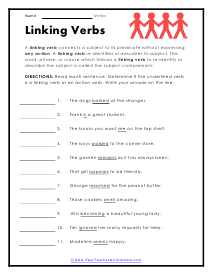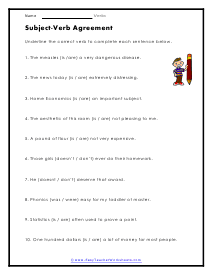This is an essential part of speech. Without this form of speech most sentences would cease to exist, and everything would be fragmented. These words are used to declare statements and ask questions. They are also the vital aspect of forming commands. Besides forming actions, they can also be used to convey a state of being. There are many different functions of these words. They can used to express actions, link sentences together, and add a sense of transition to sentences. Verbs are words that show an action, occurrence, or a state of being. Your students may be confused about the differences between verbs and predicates. Simply put, a sentence can be divided into two parts: the subject and the predicate. The predicate is everything that is not the subject, and it contains the verb. In sentences that are made up of only two words (i.e. "Jennifer cooked."), the verb and the predicate are the same thing.
Print Verb Worksheets
Click the buttons to print each worksheet and associated answer key.

The Big Olde' Helper
A main verb shows the action or the state of being in a sentence. A helper works with the main word to show when the action or state of being occurs (in the past, present or future). Some common helping verbs are: is, am, are, has, have, had, was, were, and will.

Action Words
Read each word. What part of speech is it? Write your answer on the line. Write a sentence to describe what is happening in each picture. Use that exact word in each of your sentences.



Linking Verbs
These connect a subject to its predicate without expressing any action. It re-identifies or describes its subject. The word, phrase, or clause which follows a linking verb to re-identify or describe the subject is called the subject complement.


Round 2 of "To Be"
The verb “to be” helps us to explain the condition or characteristics of people and things, what we call "state of being." The term "to be" is usually a linking verb, meaning that it links the subject of a sentence to an adjective or a noun. The word can also be used with gerunds to show action that is happening right now.



Transitive and Intransitive
Write a sentence for each word. The word form should be either a transitive or intransitive verb as indicated in parentheses.

10 Rules for Subject/Verb Agreement
On a separate page, write a sentence to demonstrate each rule of subject/verb agreement.


Tenses
Underline the action words in each sentence below. Write whether they are present, past, or future tense on the line.


Mains and Helpers
Underline the main verb in each sentence. Then rewrite each sentence below three times, changing the helper each time to change the meaning of the sentence.

Animal Sounds
Match the word in the box with the animal that does the action. The first one is done for you.
These worksheets and lessons assist you identifying these words within sentences. We will also show you how to actively use them in your writing. We will also express the phrasal use of these words in sentences that helps you write well thought out sentences. You will learn how to insure that your subject agrees with these words within your sentences. We will end by showing you how to determine the proper usage of tenses. Fun Project Idea: Have your students perform the Schoolhouse Rock "Verbs" song (available on YouTube) for extra reinforcement of the definition and use. A whole slew of worksheets for this topic can be found below.
How to Use Verbs in a Sentence
A verb is a literary device that shows an action or state of being. They can tell you what the subject is doing or what is happening to it. Every sentence will have a verb in it.
It is one of the most vital parts of speech since every sentence should contain at least one word that describes an action or occurrence. There are many different types of verbs, and each one conveys a different message about the subject - for example, some verbs describe actions that a person does (walk, eat), while others may signify states (exist, feel).
Understanding how to use verbs correctly and choose the correct ones for your sentences. Still, once you get used to it and start recognizing common patterns in your writing, this challenge becomes much easier!
Use of Verbs
We can use these terms in various ways in a sentence. They can be used as the main verb (the term that expresses the main idea or action), an auxiliary, or a modal.
For example, In the sentence ' He drives fast,' the main verb is ' drive.' In the sentence 'Can you please help me?' The main verb is 'can.'
Auxiliary forms are used to express tense, mood, and voice. For example, in the sentence 'He has written a paper for his English class,' the auxiliary verb 'has' is used to express past tense. In contrast, in the sentence 'She will write her paper tomorrow,' the auxiliary form 'will' indicates future tense.
Modal forms also help express possibility, probability, or necessity in a sentence. For example, in the sentence 'You must do your homework right now,' the modal verb 'must' indicates that the subject must do their homework at that moment.
Types of Verbs
There are three main categories of verbs: action, linking, and helping forms.
Action
Action verbs describe an action that the subject is doing or has done. These are the most common types of that are found in sentences, and they can be grouped into two categories: transitive and intransitive.
- Transitive forms require a direct object in the sentence - for example, 'He opened his lunchbox.'
- Intransitive forms don't require anything to follow them - for example, 'She walked across.
Linking Forms
A verb that links the subject of a sentence with words (often adjectives or nouns) that describe or identify the subject is called a linking verb. The most common forms of these are used for linking are:
Be, was, were, appear, seem, am, is, are, become, grow, feel, look, smell, taste.
Linking verbs do not show any action; instead, they connect the subject with information about the subject. Linking forms can be followed by a subject complement (a noun or pronoun that renames or identifies the subject) or an adjective complement (an adjective that describes the subject).
For example, in the sentence 'She is my best friend,' the linking verb is 'is,' followed by a subject complement ('my best friend'). In the sentence 'He looks tired,' the linking verb is 'looks' followed by an adjective complement ('tired').
Note: Not all verbs that appear to be linking verbs are actually are. For example, the verb 'seem' can be used as a linking verb, but it can also be used as an action verb. The verb 'become' can also be used as both linking and action verbs.
Helpers
A helping verb is a term that helps the main verb in a sentence express tense, mood, or voice. There are many different types of helpers, such as auxiliaries (which include be and do), modals (which express possibility, probability, or necessity), and semi-auxiliaries (which include having, will, and shall).
Looking at the verb 'to be' as an example, we see that it has both present (am) and past tense (was) forms. It indicates the present or future tense in a sentence (for example: 'I am writing a paper for my English class.') and has past tense forms (for example: 'She was tired when she arrived home from work').
Choosing the correct verb for your sentences can sometimes be difficult, but you may find that it becomes much easier over time with practice and attention to detail. If you're ever unsure which verb to use, consult a dictionary or grammar reference book for help.



